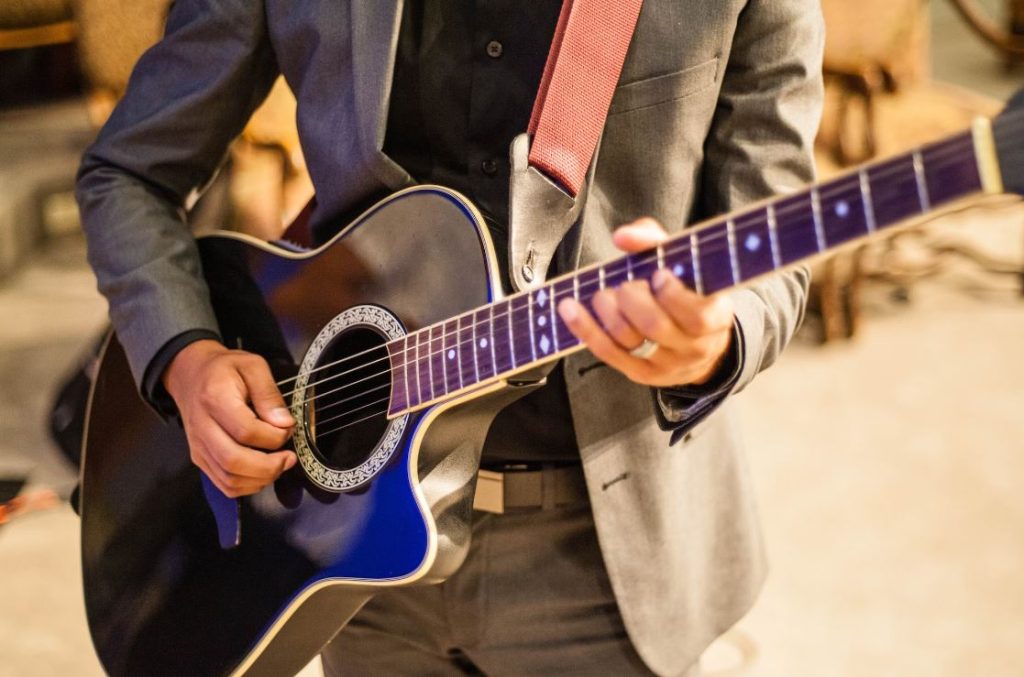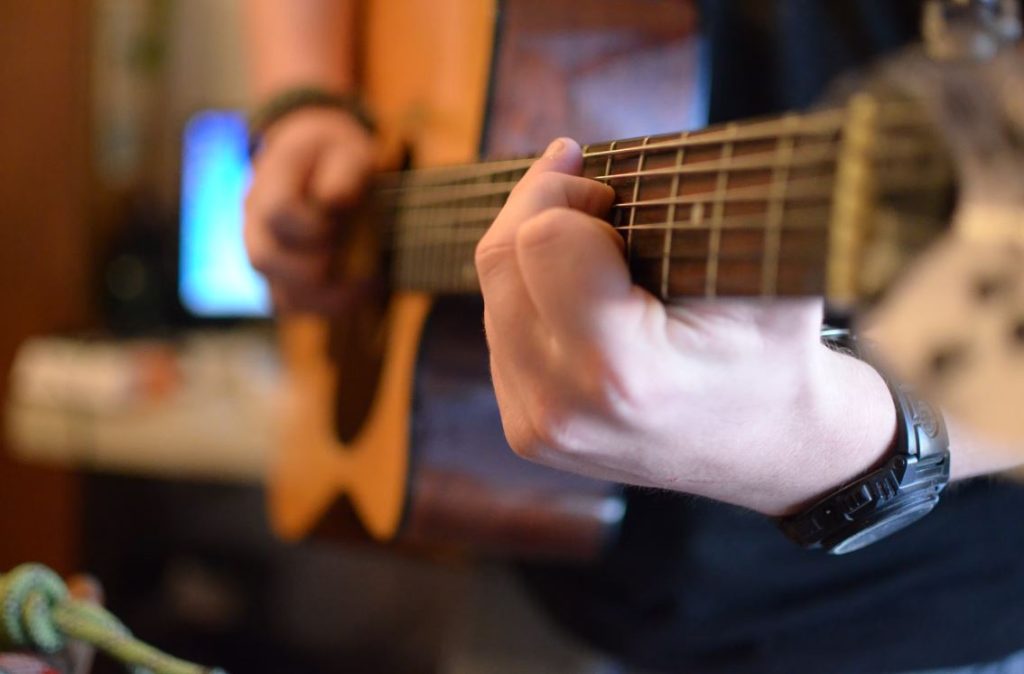This product list contains affiliate links. This means that at no extra cost to you, I may earn a commission if you use one of these links to make a purchase.
Last updated on August 31st, 2023 at 10:58 am
Strong fingers not only enhance your technique but also improve your endurance.
In this article, I’ll share expert tips on how to achieve hardened fingers for guitar playing. So, whether you’re a beginner or an experienced player, keep reading to find out how to harden your fingers and take your guitar playing to the next level.
One of the key aspects of developing hardened fingers for guitar playing is finger strengthening exercises.
These exercises help to build the muscles in your fingers, making them stronger and more resilient. In addition to finger strengthening exercises, there are other techniques you can use to build finger toughness and endurance.
By consistently incorporating these techniques into your practice routine, you’ll soon notice a significant improvement in your finger strength and guitar playing ability.
First things first, let’s delve into why finger hardening is so essential for guitarists, and how it contributes to your overall guitar playing ability.
Key Takeaways
- 🎸 Hardening your fingers is essential for better guitar playing. Consistent practice along with targeted exercises help in building calluses and improving touch sensitivity allowing more precise and controlled playing.
- 💪 Strengthening the fingers is crucial to guitar playing. Exercise routines such as hammer-ons and pull-offs, spider walks, string bending, and using hand grippers can help increase finger strength.
- 🎶 Improving finger dexterity leads to a better performance. Proper finger positioning, practicing scales, and exercises that target individual fingers aid in the enhancement of finger coordination and agility.
- 🔄 Building finger endurance enables guitarists to perform complex pieces for longer durations. Exercises include finger tapping, spider walk, finger push-ups, and scale playing.
- 🤲 Regular finger stretching exercises are a fundamental part of guitar playing. They boost finger flexibility, reduce injury risk and optimise performance, featuring exercises such as the finger walk, the spider exercise, and the finger stretch.
Why Hardening Fingers is Essential for Guitarists: How to Harden Fingers for Guitar

If you’re new to playing guitar, you may be wondering why you need to develop calluses on your fingertips. The truth is, calluses are essential for any serious guitarist. Not only do they provide protection for your fingers, but they also enhance your touch sensitivity, allowing you to play with more precision and control.
So how do you go about developing calluses effectively? The key is consistent practice. By playing regularly, you’ll gradually build up calluses on your fingertips over time. However, there are also several finger conditioning techniques you can use to speed up the process.
| Technique | Description |
|---|---|
| Playing on steel strings | Steel strings are rougher than nylon strings, which can help to develop calluses more quickly. |
| Using a pumice stone | Gently rubbing a pumice stone over your fingertips can help to remove dead skin and promote callus growth. |
| Applying rubbing alcohol | Dabbing rubbing alcohol onto your fingertips can toughen up the skin and speed up callus development. |
Remember, while calluses are important, they shouldn’t be the sole focus of your finger conditioning regimen. It’s also important to work on building finger strength and dexterity, which can help to prevent injury and improve your overall technique.
Building Finger Dexterity for Guitar
To improve your finger dexterity, try practicing scales and arpeggios at a slow, steady pace. Focus on maintaining proper finger positioning and movement, and gradually increase your speed over time. You can also try exercises that target individual fingers, such as spider crawls or finger tapping drills.
Enhancing Finger Endurance for Guitar
Playing complex guitar pieces requires a lot of finger endurance. To build endurance gradually, try incorporating exercises that involve playing for extended periods of time without stopping. For example, you might try playing a single note or chord for several minutes at a time, gradually increasing the length of time as your endurance improves. It’s important to maintain a relaxed hand and avoid excessive tension, as this can lead to injury.
Stretching Exercises for Guitar Fingers
Stretching is also an important part of any finger conditioning routine. Before you start playing, try incorporating some gentle finger stretches into your warm-up routine. This can help to improve your finger flexibility and reach, which can in turn improve your overall playing ability. Some good finger stretching exercises include finger extensions, finger bends, and finger rolls.
By incorporating these finger conditioning techniques into your regular practice routine, you’ll be well on your way to developing the strong, callused fingers needed for guitar playing success!
Also Read: Why New Nylon Strings Won’t Stay In Tune
How to Harden Fingers for Guitar: Strengthening Exercises
One of the key factors in hardening your fingers for guitar playing is building finger strength. As a guitarist, I know that playing the guitar can be a bit strenuous for the fingers, especially if you’re a beginner. That’s why I recommend incorporating finger strength training exercises into your daily practice routine.
Here are some finger strength training exercises for guitarists:
| Exercise | Description |
|---|---|
| Hammer-ons and Pull-offs | Place your index finger on the fifth fret of the thickest string. Hammer your middle finger on the sixth fret, then pull it off. Repeat this on all the fingers of your left hand. |
| Spider Walks | Start with your index finger on the fifth fret of the thinnest string and play each fret with every finger until you reach the eighth fret. Move your hand up to the next string and repeat. |
| String Bending | Take the 3rd finger of your left hand and place it on the third string of the guitar. Bend the string up, then release. Repeat this on all the strings. |
| Hand Grippers | Use a hand gripper to increase finger strength. Squeeze the gripper for 5 seconds, then release. Repeat this for 10-15 reps daily. |
Remember to start each exercise slowly and gradually increase the difficulty as you progress. With consistent practice, you’ll see an improvement in finger strength and endurance.
If you’re finding it difficult to perform these exercises, you can start with finger strength building tools such as finger exercisers, hand grips, and finger weights to help.
Practice these exercises regularly, and soon you’ll be able to play your favorite guitar riffs with ease.
Also Read: Nylon or Steel Strings: Quick Tips for Stellar Performance
How to Harden Fingers for Guitar: Improving Dexterity
As a guitarist, I know that finger dexterity is crucial to playing complex pieces with ease and accuracy. In this section, I will provide tips and exercises to help you improve your finger coordination and agility.
To start, it is essential to focus on proper finger positioning and movement. Keep your fingers close to the fretboard, and use the tips of your fingers to press down on the strings. When playing multiple notes, use the fingers of your left hand to form chords and position them correctly.
One of the most effective ways to build finger dexterity is by practicing scales. Start with simple scales, such as the C Major scale, and gradually increase the difficulty as you improve. Practice each scale slowly and gradually increase the tempo as you become more comfortable.
Another great exercise for building finger strength and dexterity is the spider exercise. Start by placing your first finger on the first fret of the E string, your second finger on the second fret, and so on until you reach the fourth finger. Once you have reached the fourth finger, reverse the order and move back down the fretboard. Repeat this exercise on each string, gradually increasing the speed as you go.
It is also helpful to practice exercises that target individual fingers to enhance overall dexterity. For example, the two-finger exercise, where you only use your first and third finger, can be a great way to improve coordination between those two fingers.
Don’t forget to incorporate finger conditioning exercises into your practice routine to keep your fingers strong and healthy. This can include using a grip strengthener or stress ball to improve finger strength.
With consistent practice, anyone can improve their finger dexterity for guitar playing. By implementing these tips and exercises into your practice routine, you will see significant improvements in your playing ability.
Also Read: How to Cut Guitar Strings: A Comprehensive Guide for Beginners, Hobbyists, and Aspiring Technicians
How to Harden Fingers for Guitar: Enhancing Endurance

Building up finger endurance is essential for guitar players who want to tackle complex pieces or perform for long durations without experiencing fatigue or injury. Here are some effective exercises for improving finger endurance:
- Finger Tapping: This exercise involves tapping each finger individually on a flat surface while maintaining a steady rhythm. Start at a comfortable pace and gradually increase the speed over time.
- Spider Walk: Place your hand on a flat surface with fingers spread out. Now lift each finger one by one, starting from the pinky finger. Hold each finger in the lifted position for a few seconds before lowering it again.
- Finger Push-Ups: This exercise involves pressing down on a hard surface with your fingertips, similar to a push-up motion. Start with a few repetitions and gradually increase the number over time.
- Scale Playing: Practice playing scales for an extended period of time, gradually increasing tempo and complexity over time. This exercise helps build finger endurance while also improving technique.
Remember to maintain a relaxed hand and avoid tensing up during these exercises. Incorporate them into your regular practice routine for optimal results.
How to Harden Fingers for Guitar: Stretching Exercises
Stretching exercises are essential for improving finger flexibility and reach. They can help reduce the risk of injury and enhance overall performance. Incorporating stretching into your warm-up routine can help prepare your fingers for playing and prevent cramping.
Here are some effective finger stretching exercises for guitar:
- The Finger Walk: Start by placing your fingers on the frets of your guitar and lift them one by one in a sequential manner, like you are taking a walk. Hold each finger in the air for a few seconds before placing it back on the fret. Repeat this exercise for a few minutes.
- The Spider Exercise: Place your fingers on the frets as you would for the Finger Walk. Starting with your pinky finger, lift one finger at a time and place it on the next fret. After reaching the first string, start moving towards the opposite end of the fretboard. Repeat the exercise a few times.
- The Finger Stretch: Place your hand on a flat surface with your palm facing down. Spread your fingers as far apart as possible and hold the stretch for a few seconds. Then, bring your fingers together and make a fist. Repeat this exercise a few times for both hands.
Remember to listen to your body and not overstretch. Gradually increase the intensity of these exercises over time for optimal results. Incorporate these exercises into your daily practice routine to enhance your finger flexibility and reach.
Conclusion
We have covered various techniques and exercises that can help in developing finger calluses, improving finger strength, dexterity, endurance, and flexibility. Remember to start slowly, listen to your body, and gradually increase intensity and duration.
It is essential to maintain proper hand positioning and avoid excessive tension to prevent injury and ensure optimal performance. Incorporating these tips and exercises into your regular practice routine will help you achieve the finger hardness you need for exceptional guitar playing.


